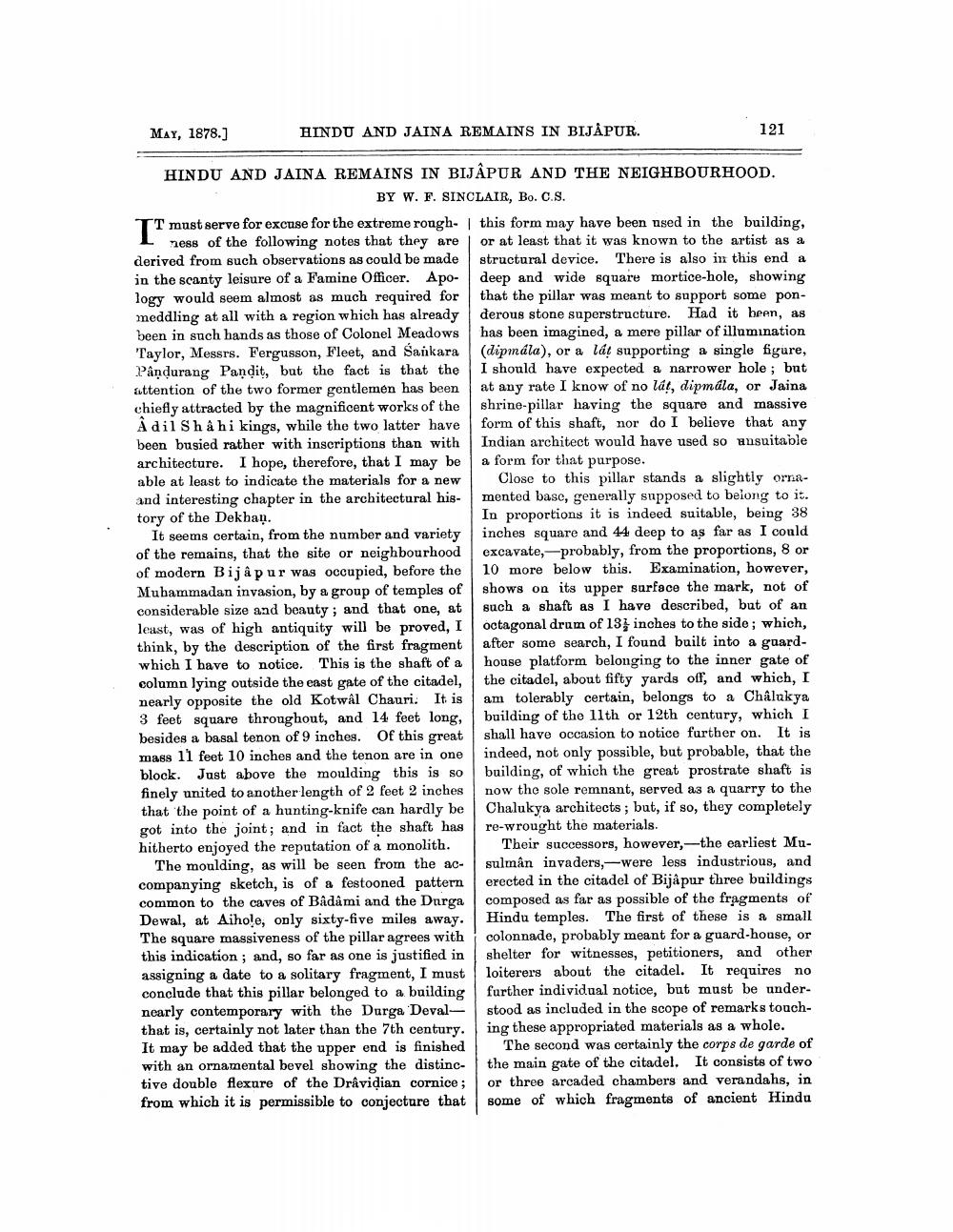________________
MAY, 1878.]
HINDU AND JAINA REMAINS IN BIJAPUR.
121
HINDU AND JAINA REMAINS IN BIJAPUR AND THE NEIGHBOURHOOD.
BY W. F. SINCLAIR, Bo. C.S. TT must serve for excuse for the extreme rough- this form may have been used in the building,
ness of the following notes that they are or at least that it was known to the artist as a derived from such observations as could be made structural device. There is also in this end a in the scanty leisure of a Famine Officer. Apo- deep and wide square mortice-hole, showing logy would seem almost as much required for that the pillar was meant to support some ponmeddling at all with a region which has already derous stone superstructure. Had it been, as been in such hands as those of Colonel Meadows has been imagined, a mere pillar of illumination Taylor, Messrs. Fergusson, Fleet, and Sankara (dipmála), or a lát supporting a single figure, Pandurang Pandit, but the fact is that the I should have expected a narrower hole; but attention of the two former gentlemen has been at any rate I know of no lar, dipmdla, or Jaina chiefly attracted by the magnificent works of the shrine pillar having the square and massive Adil Sh à hi kings, while the two latter have form of this shaft, nor do I believe that any been busied rather with inscriptions than with Indian architect would have used so unsuitable architecture. I hope, therefore, that I may be a form for that purpose. able at least to indicate the materials for a new Close to this pillar stands a slightly omaand interesting chapter in the architectural his- mented base, generally supposed to belong to it. tory of the Dekhan.
In proportions it is indeed suitable, being 38 It seems certain, from the number and variety inches square and 44 deep to as far as I could of the remains, that the site or neighbourhood excavate,-probably, from the proportions, 8 or of modern Bijapur was occupied, before the 10 more below this. Examination, however, Muhammadan invasion, by a group of temples of shows on its upper surface the mark, not of considerable size and beauty; and that one, at such a shaft as I have described, but of an least, was of high antiquity will be proved, I octagonal drum of 13} inches to the side; which, think, by the description of the first fragment after some search, I found built into a guardwhich I have to notice. This is the shaft of a house platform belonging to the inner gate of column lying outside the east gate of the citadel, the citadel, about fifty yards off, and which, I nearly opposite the old Kotwal Chauri. It is am tolerably certain, belongs to a Châlukya 3 feet square throughout, and 14 feet long, building of the 11th or 12th century, which I besides a basal tenon of 9 inches. Of this great shall have occasion to notice further on. It is mass 11 feet 10 inches and the tenon are in one indeed, not only possible, but probable, that the block. Just above the moulding this is so building, of which the great prostrate shaft is finely united to another length of 2 feet 2 inches now the sole remnant, served as a quarry to the that the point of a hunting-knife can hardly be Chalukya architects; but, if so, they completely got into the joint; and in fact the shaft has re-wrought the materials. hitherto enjoyed the reputation of a monolith. Their successors, however,-the earliest Mu
The moulding, as will be seen from the ac- sulmán invaders, were less industrious, and companying sketch, is of a festooned pattern erected in the citadel of Bijapur three buildings common to the caves of Bâdami and the Durga composed as far as possible of the fragments of Dewal, at Aiho!e, only sixty-five miles away. Hindu temples. The first of these is a small The square massiveness of the pillar agrees with colonnade, probably meant for a guard-house, or this indication; and, so far as one is justified in shelter for witnesses, petitioners, and other assigning a date to a solitary fragment, I must loiterers about the citadel. It requires no conclude that this pillar belonged to a building further individual notice, but must be undernearly contemporary with the Durga Deval- stood as included in the scope of remarks touchthat is, certainly not later than the 7th century. ing these appropriated materials as a whole. It may be added that the upper end is finished The second was certainly the corps de garde of with an ornamental bevel showing the distinc- the main gate of the citadel. It consists of two tive double flexure of the Dravidian cornice; or three arcaded chambers and verandahs, in from which it is permissible to conjecture that some of which fragments of ancient Hindu




